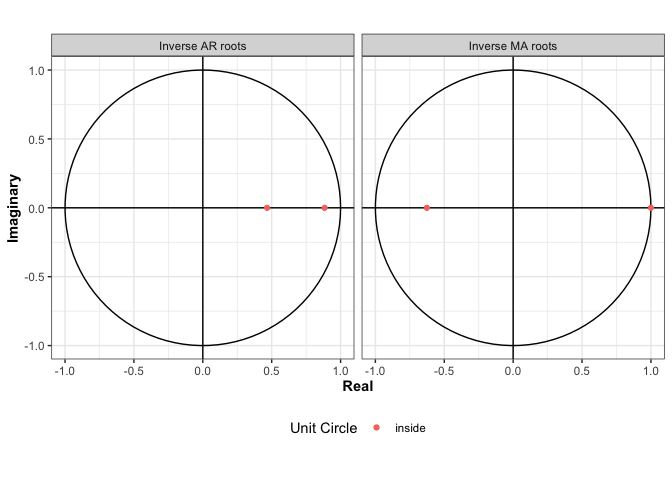
The goal of arima2 is to provide a set of tools to aid
in the analysis of time series data in R. One such function
is arima2::arima, which provides an interface to estimating
Auto Regressive Integrated Moving Average (ARIMA) models using a
random-restart algorithm. This function improves on the functionality of
the stats::arima method, as it has the potential to
increase the likelihood of the final output model. By design, the
function cannot result in models with lower likelihoods than that of the
stats::arima function. The potential for increased model
likelihoods is obtained at the cost of computational efficiency. The
function is approximately \(n\) times
slower than the stats::arima function, where \(n\) is the number of random restarts. The
benefit of trying multiple restarts becomes smaller as the number of
available observations increases. Because the estimation of ARIMA models
takes only a fraction of a second on relatively small data sets (less
than a thousand observations), we are of the opinion that potential to
increase model likelihoods is well worth this computational cost. The
arima function implementation relies heavily on the source
code of the stats::arima function.
# Install from CRAN
install.packages("arima2")You can install the development version of arima2 from
GitHub with:
# install.packages("devtools")
devtools::install_github("jeswheel/arima2")This is a basic example which shows you how to solve a common problem:
library(arima2)
#>
#> Attaching package: 'arima2'
#> The following object is masked from 'package:stats':
#>
#> arima
set.seed(851348)
coefs <- c("ar1" = -0.3, "ar2" = -0.3, 'ma1' = -0.2, 'ma2' = 0.1)
intercept <- 20
# Generate data from ARMA model
x <- intercept + arima.sim(
n = 100,
model = list(ar = coefs[grepl("^ar[[:digit:]]+", names(coefs))],
ma = coefs[grepl("^ma[[:digit:]]+", names(coefs))])
)
arma <- stats::arima(x, order = c(2, 0, 2), SSinit = "Rossignol2011")
arma2 <- arima2::arima(x, order = c(2, 0, 2), SSinit = "Rossignol2011")In the example above, the resulting log-likelihood of the
stats::arima function is -121.49, and the log-likelihood of
the arima function is -119.1. For this particular model and
dataset, the random restart algorithm implemented in arima2
improved the model likelihood by 2.39 log-likelihood units.
Our package creates a new S3 object that we call
Arima2, which extends the Arima class of the
stats package. Once the model has been fit, our package
includes some features that help diagnose the fitted model using this
new child class. For example, ARMApolyroots function will
return the AR or MA polynomial roots of the fitted model:
ARMApolyroots(arma2, type = 'AR')
#> [1] 1.206337-2.524355e-29i 52.741787+2.524355e-29i
ARMApolyroots(arma2, type = 'MA')
#> [1] 1.171567+0.4408999i 1.171567-0.4408999iWe have also implemented a plot.Arima2 function that
uses the ggplot2 package so that we can visualize a fitted
model. To compare the roots of the model fit using multiple restarts to
the model fit using stats::arima, I will modify the class
of the arma object so that it can easily be plotted:
class(arma) <- c("Arima2", class(arma))
plot(arma)
plot(arma2)
Finally, if a user would like help in determining an appropriate
number of coefficients, we provide the aicTable function.
The package also includes an aicTable function, which
prints the AIC values for all ARMA\((p, d,
q)\), with \(p \leq P\), \(q \leq Q\), and \(d = D\):
set.seed(443252)
tab_results <- aicTable(x, P = 4, Q = 4, D = 0)
#> Warning in arima(data, order = c(p, D, q), ...): possible convergence problem:
#> optim gave code = 1
tab_results |> knitr::kable()| MA0 | MA1 | MA2 | MA3 | MA4 | |
|---|---|---|---|---|---|
| AR0 | 278.5279 | 251.2556 | 251.1541 | 252.7329 | 247.8627 |
| AR1 | 252.4657 | 251.2814 | 248.2125 | 250.2045 | 249.8406 |
| AR2 | 252.6433 | 251.2406 | 250.2017 | 245.6692 | 251.2409 |
| AR3 | 251.2595 | 253.2591 | 251.3298 | 251.2216 | 250.2504 |
| AR4 | 253.2583 | 248.2554 | 249.8175 | 252.3539 | 248.6465 |
P <- which(tab_results == min(tab_results), arr.ind = TRUE)[1] - 1
Q <- which(tab_results == min(tab_results), arr.ind = TRUE)[2] - 1
print(paste0("p = ", P, "; q = ", Q))
#> [1] "p = 2; q = 3"For more details about this package, please see our published article:
Wheeler J, Ionides EL (2025). “Revisiting inference for ARMA models: Improved fits and superior confidence intervals.” PLOS ONE, 20(10), 1-19. 10.1371/journal.pone.0333993.